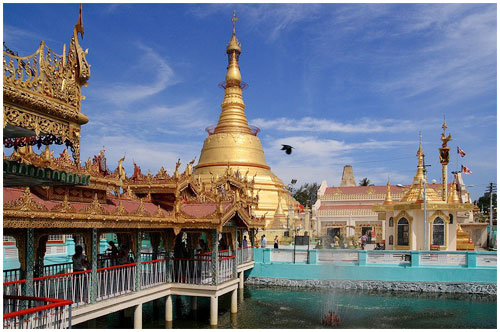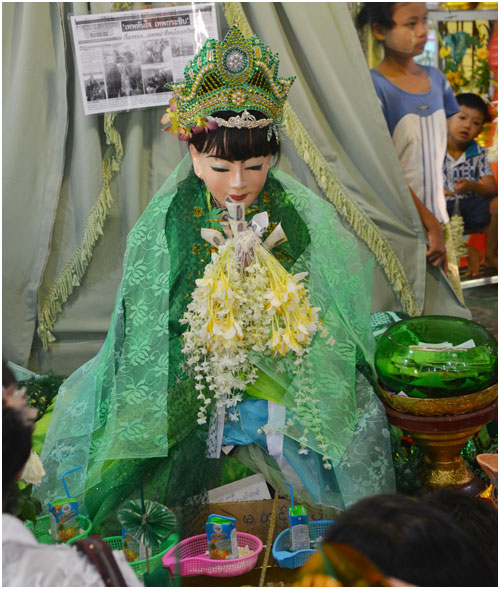
Yangon, the capital city, is the main gateway to Myanmar. Evergreen and cool with lush tropical trees, shady parks and beautiful lakes. Yangon has earned the name of "The Garden City of the East". Yangon was founded by King Alaungpaya on the site of a small settlement called Dagon when he conquered Lower Myanmar in 1755. The name Yangon means "End of Strife" which was anglicized as Rangoon by the British. The name of this city has changed along the history: first Dagon, then Yangon, and Okalapa Aung Myae Yan Hnin, then finally back to Yangon. The present day Yangon covers 400 sq m and has a population of over 5 million.
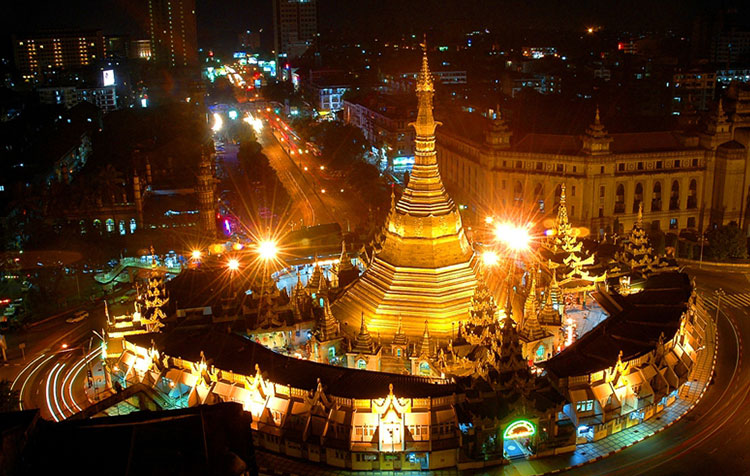
Sule Pagoda:
The landmark at the Yangon City center and symbol of downtown Yangon is situated right at the heart of the city. The Sule Pagoda is said to be over 2,000 years old, enshrining a hair relics of the Buddha. The golden pagoda is unusual in that its octagonal shape continues right up to the top terrace. It stands 46 meters (152 feet) high and is surrounded by small shops of all the familiar non-religious services such as astrologers, palmists, photo studios and watch repair. From there, you may observe the atmosphere of the Yangon center with crowed people from all walks of life in various trades, and busy traffic.
Downtown:
On a city tour to downtown and Yangon's riverfront you will see many of the remarkable sites of the colonial and religious past of this garden city. Old Rangoon was Dr William Montgomerie's design. He was the army superintendent surgeon and learnt his city planning skills from Sir Stanford Raffles in Singapore. Buildings of heritage in Yangon are now listed for protection. The period architecture of the old city center, among others, includes: The City Hall, designed by U Tin in 1925, incorporates Myanmar themes into its facade, including floral motifs and mythical creatures. The High Court, a red brick extravaganza by the architect John Ransome built in 1911. The impressive building sports a clock tower whose four faces are lighted at night, and can be seen floating above the city centre. The Strand Hotel built in 1896, once described as the "leading hotel of the East". The Strand has long been recognized as a national landmark, a model of auspicious, colonial repose. The hotel's Victorian influence is visible even from the colonnaded entranceway.
The Customs House was built of red brick in 1902. The Township Judicial Offices building, a long grey structure with high pillars, finished in 1920 was once headquarter of the Burma Socialist Program Party. The towered Myanmar Port Authority, on the corner of Strand Road and Pansodan Street. The office of the Ministry of Information, built in 1918, is a four-story structure with austere pillars that originally served as a bank, then as the National Museum and has now been returned to its original duty as a bank. The Yangon Division Court House built in 1912, in the Queen Anne architectural style. The Rander House, at the corner of Pansodan Street and Merchant Street.
The adjacent Government Telegraph Office was erected the same year as the High Court - though a fresh coat of paint ensures that it looks as striking as architect John Begg intended. The compound of the Secretariat along Mahabandoola Street and Bo Aung Kyaw Street. Construction began in 1980 and was finished 1905, resulting a massive red brick building with four wings radiating out from a central dome. It was here in 1947 that General Aung San and five members of his cabinet were assassinated during a meeting. The Yangon General Hospital, impressively designed with expansive arches and towering turrets was, upon its completion in 1911, the first public building in Myanmar constructed of reinforced concrete. The Railway Station, ornamented with Traditional Myanmar motifs.
Pansodan Jetty:
The jetty is situated in front of the famous Strand Hotel. From there, you may observe the daily lives of people who came across the river from the other side of the city for working or selling their local products. You can cross the river by ferry boat, which takes about 10 minutes to return.
Yangon Sunset Cruise:
RV Mahaythi
The RV Mahaythi has daily (guarantee minimum 2 persons departure) Yangon Sunset Cruises. Departure from Botataung Jetty at 16:30 P.M. and arrival at War-tan Jetty is at 18:30 P.M. The City Circular Train:
If you wish to drive through rural areas, stopping at numerous stations watching cigarette sellers, betelnut sellers, fortune tellers, and, and, and... - then just buy a ticket for the 2 1/2 hour ride.
Botataung Pagoda:
|
|
|
The Botataung Pagoda was a famous Land-mark on Rangoon's waterfront. Situated just below the long lines of jetties that serve this busy port whence rice, petroleum, timber and mineral are shipped to the whole world. |
|
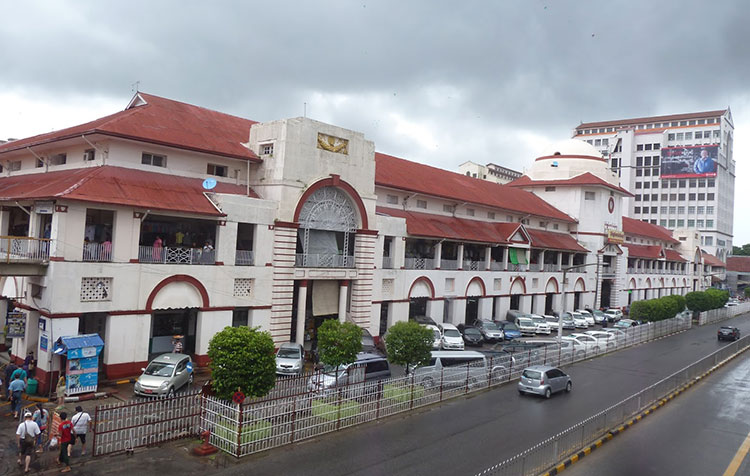
Bogyoke Aung San Market:
Formerly known as Scott Market, it is the most famous place for shopping in Yangon. Myanmar arts and handicrafts are best souvenirs available there at reasonable prices. Lacquerware, wood and ivory carvings, tapestries, silverware, brassware, silk and cotton fabrics, and shoulder bags as well as jewelry are some of the most favorite items it has to offer.
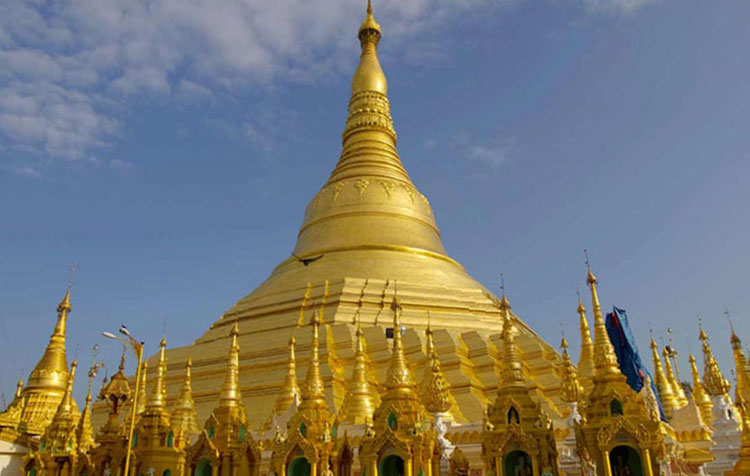
Shwedagon Pagoda:
The most significant and the pride of Myanmar, the ancient stupa towers almost 100 meters above the green cityscape of Yangon. The great golden Shwedagon Pagoda is the prominent landmark visible from miles around, where the holy hair relics of the Buddha were enshrined more than 2,500 years ago. It is one of the wonders of the world and the most venerable pagoda in Southeast Asia. It is the essence of Myanmar and a cultural splendor that never fails to enchant. A visit to Yangon would be incomplete without a call at the Shwedagon. There you may observe not only the wealth of ancient Myanmar architecture and artistic craftsmanship as it has developed throughout the ages, but also the deeds of Buddhist rituals such as offering water, candles, incense sticks and flowers to the Buddha.
National Museum:
Located on Pyay Road, about a few minutes away from downtown, the newly built five-storied museum will let you know the glory of Myanmar. It exhibits the Lion Throne of the last Myanmar king, royal regalia of 19th century Myanmar kingdom, artifacts of various ancient periods, articles of cultural heritage and archaeological value, art and craft articles, weaponry, musical instruments and paintings.
Chaukhtatgyi Pagoda:
Located 10 minutes away from downtown, and 5 minutes from the famous Shwedagon Pagoda, the 72 meters long reclining Buddha image is the biggest colossal reclining Buddha image in Myanmar. Originally built in 1907, it has suffered damage due to climate over the years. In 1957, it was demolished and rebuilt to this structure and completed in 1966. The uniqueness of the image is the glass mosaic on the sole of its feet representing the 108 special characteristics of the Buddha.
Bogyoke Aung San Park:
A scenic park composed of numerous hills and shady green trees, surrounding the beautiful lake of Kandawgyi, one of two major lakes in Yangon, is located 5 minutes away from downtown. The Park is a nearest retreat and popular recreation center where city-dwellers can relax and enjoy their leisure time in peace and tranquility. The playgrounds and picnic areas are favorite spots for children and teenagers.
Zoological Garden:
Located near the Kandawgyi Palace Hotel, the Yangon Zoo is noted for its collection of wild animals from around the world, rare species, flora and fauna, which have been collected over the years since it was opened in 1906. On weekends and public holidays, snake dance and elephant circus are performed for visitors. The Zoological Garden Amusement Park is also a well-known spot for children and teenagers.
Natural History Museum
Situated near the Kandawgyi Lake, the Natural History Museum has a notable collection of Myanmar's geographical, biological and archaeological diversity including flora and fauna, forest products, minerals and rocks.
People's Square and People's Park
People's Square and People's Park occupy over 130 acres of land between Shwedagon Pagoda and Pyithu Hluttaw (the Parliament). There is a museum housing life-size models of nationalities in their colorful dress. A restaurant in the Park serves Myanmar, Chinese and European cuisine.
Myanmar Gems Museum:
Of the 100 counters in the building 30 on the ground floor, 34 each on the first and second floors are privately owned, whereas the remaining two counters on the ground floor are run by the Myanmar Gems Enterprise and Myanmar VES Joint Venture Co., Ltd. These three floors of the Gems Mart present the whole range of Myanmar ruby, sapphire, period and a variety of assorted colored stones, jade, pearls in lots or embedded in exquisite jewelry, gold ware, silverware and jade figurines. These are sold in Myanmar Kyats, US$ or foreign exchange certificates (FEC). The Myanmar Gems Enterprise (MGE) under the Ministry of Mines annually holds an auction at the Emporium.
In the gems museum, you will find ruby, jade, pearl and the jewelry counters.
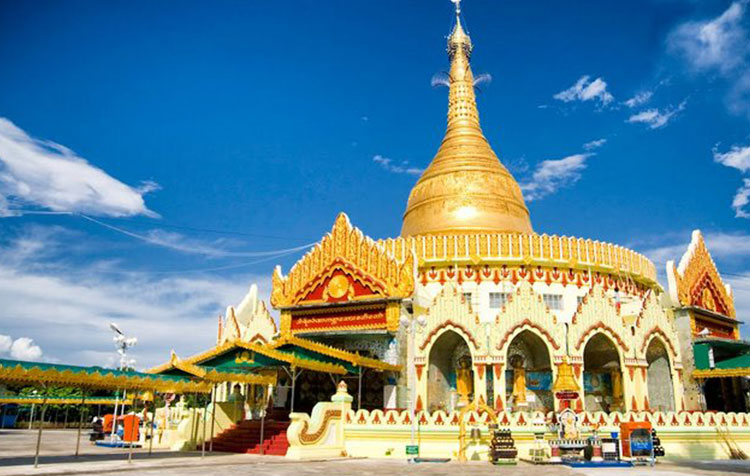
Kabar Aye Pagoda (World Peace Pagoda):
Built in 1954 in dedication to the 1954-56 Sixth Buddhist Council. This 111-feet-high pagoda measures 34 meters around the base.
Buddhist Art Museum:
The Buddhist Art Museum at the Kabar Aye Pagoda has a wide collection of religious paraphernalia and Buddhist texts.
Maha Pasana Cave:
This great cave is a man-made cave built for the Sixth Buddhist Council, which was held to coincide with the 2500th anniversary of the Buddha's enlightenment. The participants recited, edited, and approved the entire Buddhist scriptures known as the Three Pitakat. The cavern measures 455 by 370 feet.
Mae La Mu Pagoda:
Mae La Mu Pagoda located in the suburb of Yangon is a wonderland of sculptured figures and famous for the giant images depicting Buddha's earlier lives.
White Elephants:
Within the walking distance from Minn Dhamma Hill, there is an Elephant house where the three white elephants are kept. In many Asian countries including Myanmar, white elephant is regarded as a supreme royal ornament.
National Races Village:
National races village is situated in Tharketa Township, on the left of Yangon-Thanlyin Bridge. You will not only enjoy fresh breeze blowing across Bago River but also get the sense of Union Spirit from the village of national brethren, Kachin, Kayah, Kayin, Chin, Bamar, Mon, Rakhine and Shan. You can see buildings with significant symbols denoting various national races residing in the country.
ENVIRONS:
Hlawga Wildlife Park:
The Hlawga Wildlife Park is about 45 minutes' drive from downtown. The park, which covers 1,650 acres of land and lake is home for over 70 kinds of herbivorous animals and 90 species of birds. It has a museum of the replica of Myanmar traditional buildings and a small zoo with rock garden. Flocks of migratory birds frequently visit the park. It is an ideal place for picnickers, naturalists, botanists and bird-watchers. Visitor can also enjoy elephant rides, boating and fishing in the park.
Htaukkyant World War II Cemetery:
Located at Htaukkyant, about 32 km from Yangon on the road to Bago, there is a memorial cemetery of Allied soldiers who died in the Burma Campaign during World War II. The cemetery's beautifully kept compound has 27,000 tombstones of fallen Common Wealth and Allied soldiers.
Bago (Pegu):
The ancient capital of the Mon Kings from the 14th through 16th century and that of the Second Myanmar Empire founded by King Bayinnaung, Bago is situated only 80 km from Yangon. Places of interest in Bago are Shwemawdaw Pagoda, the highest pagoda in Myanmar with the elevation of 117 meters, built over 2,000 years ago by two merchants; the famous Kalyani Thein (Ordination Hall); Shwethalyaung Reclining Buddha, which was built during 9th century and one of the most elegant reclining Buddha images, stretching 55 meters; four huge Buddha images of Kyaikpun Pagoda; and the Bago Market.
Thanlyin (Syriam):
Only 45 minutes by ferry across the Bago River or about 30 minutes' drive from Yangon lies Thanlyin. It was a major port and important trading centre from the 14th through the 18th century until it was displaced by Yangon in 1755. It was briefly controlled by the Portuguese adventurer, de Brito, at the beginning of the 17th century. The ruins of a Catholic church built by an Italian missionary in the 18th century can still be seen in Thanlyin. Kyeik-khauk Pagoda in
Thanlyin and Yele Pagoda (a pagoda on a small island) at Kyauktan are worth visiting. You may also observe the local ways of making ceramic products at Bogyoke Village.
Twante:
A small town on Twante Canal, it is 24 km from Yangon and takes about two hours by boat along the canal. The boat trip provides a view of the life along the canal while Twante itself provides interest as a center of pottery and hand-woven cotton cloth. The RV Mahaythi has daily (guarantee minimum 2 persons departure) river cruises to Twante. Pick-up from your hotel is at 07:00 and you will be back in Yangon at appr. 15:00 P.M.
Letkokone Beach:
It is the nearest beach from Yangon, a distance of just under three hours drive, after ferry- crossing the Hlaing i.e., Yangon river. Letkokon village and Ywa Thit Kone village just a kilometer further away are small fishing villages. Fresh and delicious seafood and juicy tropical fruit of the season can be enjoyed to your contentment. A Sunbath under the shady coconut groves sipping tender coconut milk under the sunny sky would be a pleasant time to pass. The one and only hotel, the "Letkokon Beach Hotel" with a number of Chalet type bungalows is located at the end of the driveway leading from the beach. Poor road, electricity supply, telecoms, accommodation, fresh clean water, modern conveniences and other facilities are limited. Over a century old monastery of teak logs and planks and another about half a century old are in the vicinity of Ywa Thit Kone. The Ayeyarwady River, which branches into several rivulets in the Delta Region before entering into the sea deposits fertile silt to form the Delta, where nutrient and fragrant rice cultivation, thrives on the rich soil. During the monsoon and high waters the sea is rather muddy.
The Chaung Tha Beach further west, the Kan Thar Yar Beach and the Ngapali Beach in the north-west on the Rakhine Coast where the sea water is clear for swimming and surfing. Facilities are better.


